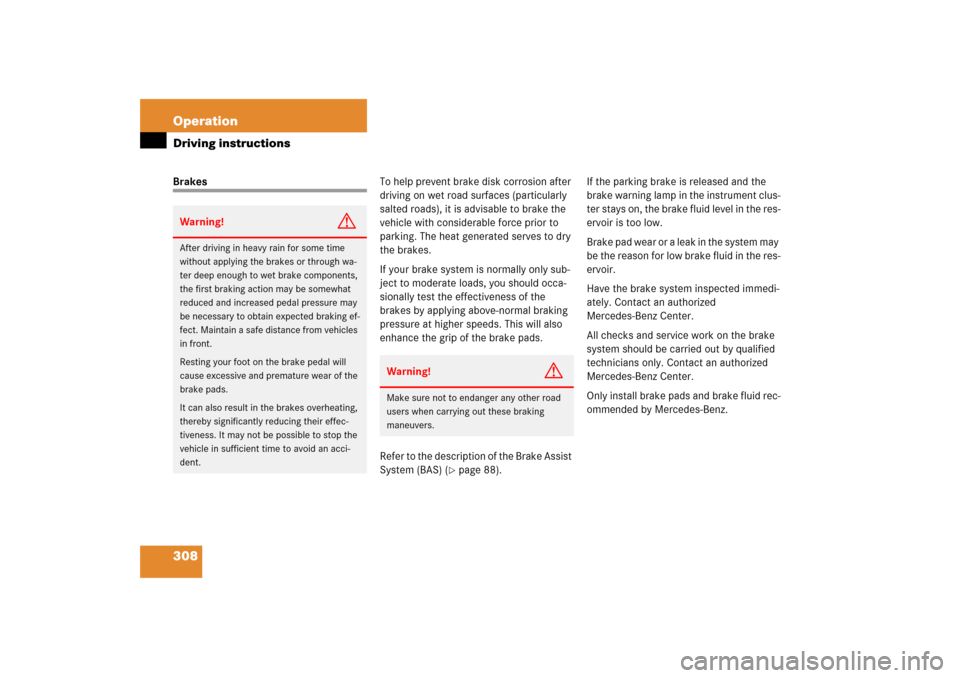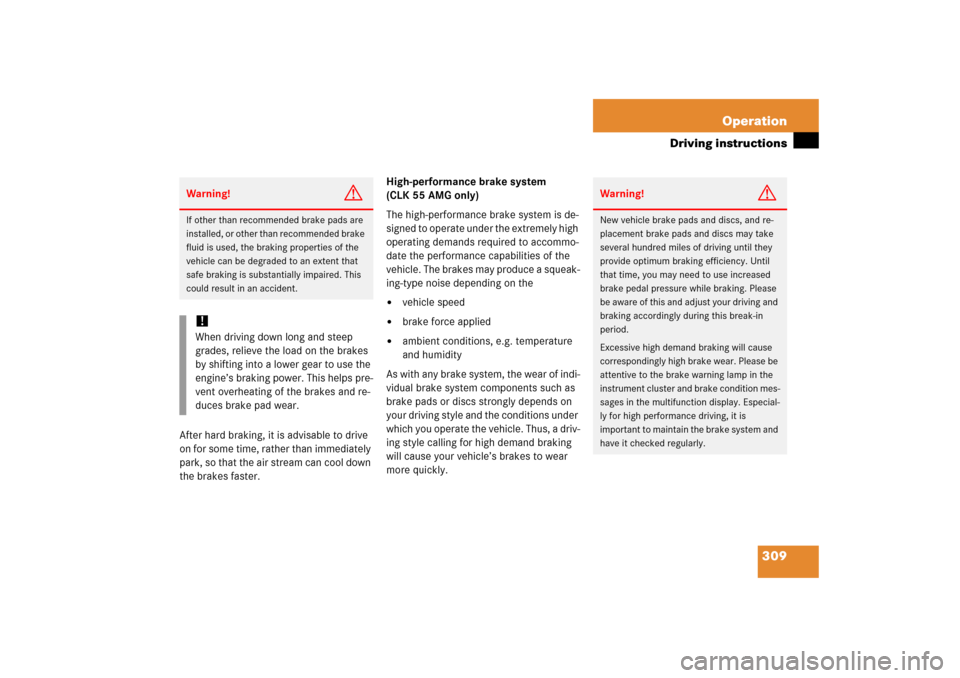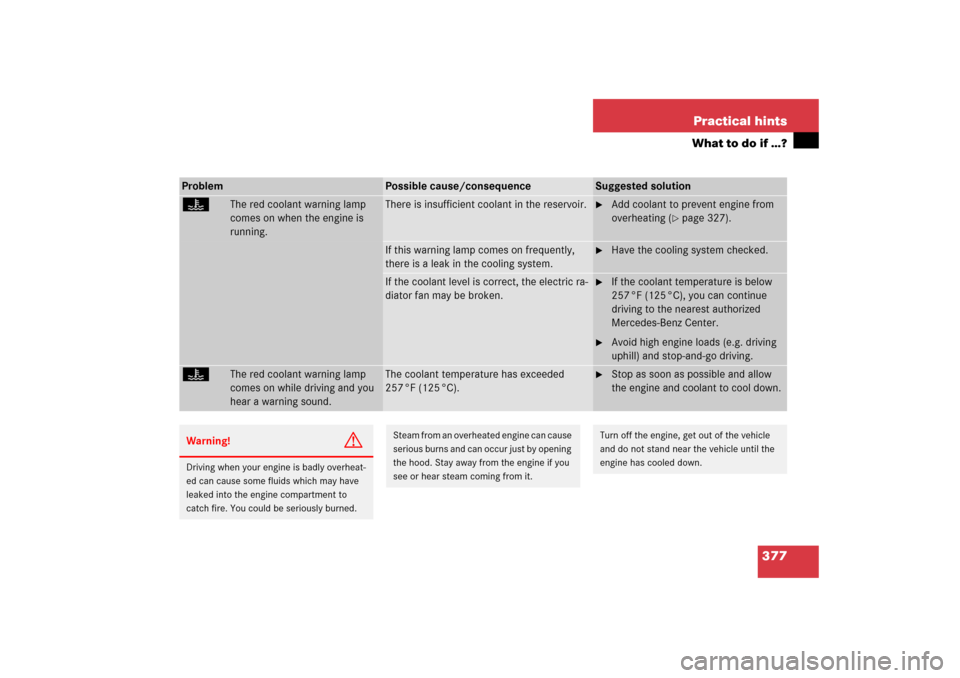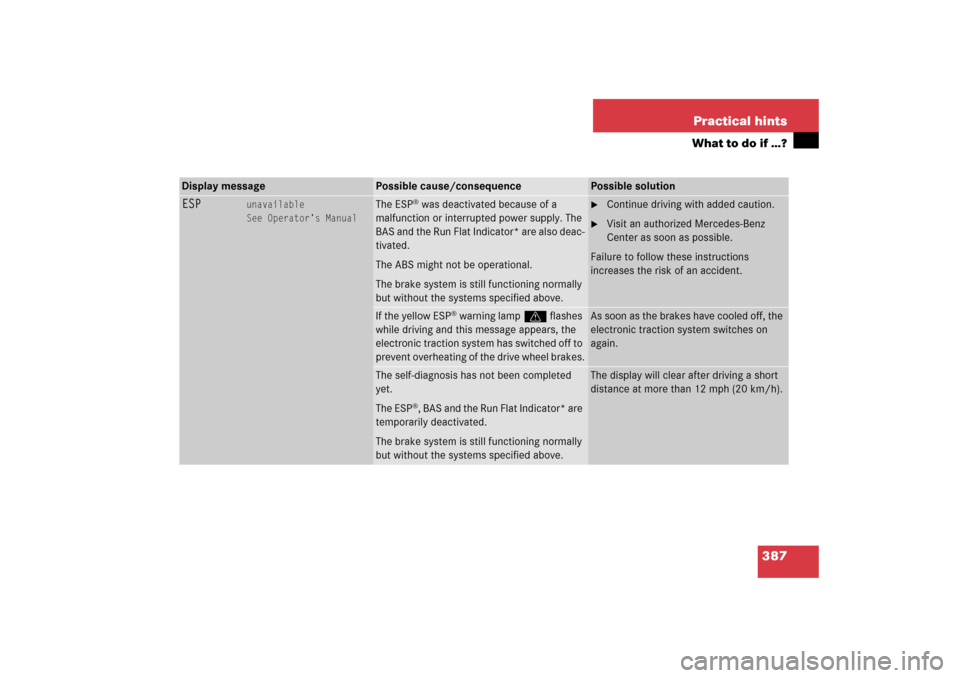Page 309 of 514

308 OperationDriving instructionsBrakesTo help prevent brake disk corrosion after
driving on wet road surfaces (particularly
salted roads), it is advisable to brake the
vehicle with considerable force prior to
parking. The heat generated serves to dry
the brakes.
If your brake system is normally only sub-
ject to moderate loads, you should occa-
sionally test the effectiveness of the
brakes by applying above-normal braking
pressure at higher speeds. This will also
enhance the grip of the brake pads.
Refer to the description of the Brake Assist
System (BAS) (
�page 88).If the parking brake is released and the
brake warning lamp in the instrument clus-
ter stays on, the brake fluid level in the res-
ervoir is too low.
Brake pad wear or a leak in the system may
be the reason for low brake fluid in the res-
ervoir.
Have the brake system inspected immedi-
ately. Contact an authorized
Mercedes-Benz Center.
All checks and service work on the brake
system should be carried out by qualified
technicians only. Contact an authorized
Mercedes-Benz Center.
Only install brake pads and brake fluid rec-
ommended by Mercedes-Benz.
Warning!
G
After driving in heavy rain for some time
without applying the brakes or through wa-
ter deep enough to wet brake components,
the first braking action may be somewhat
reduced and increased pedal pressure may
be necessary to obtain expected braking ef-
fect. Maintain a safe distance from vehicles
in front.
Resting your foot on the brake pedal will
cause excessive and premature wear of the
brake pads.
It can also result in the brakes overheating,
thereby significantly reducing their effec-
tiveness. It may not be possible to stop the
vehicle in sufficient time to avoid an acci-
dent.
Warning!
G
Make sure not to endanger any other road
users when carrying out these braking
maneuvers.
Page 310 of 514

309 Operation
Driving instructions
After hard braking, it is advisable to drive
on for some time, rather than immediately
park, so that the air stream can cool down
the brakes faster.High-performance brake system
(CLK 55 AMG only)
The high-performance brake system is de-
signed to operate under the extremely high
operating demands required to accommo-
date the performance capabilities of the
vehicle. The brakes may produce a squeak-
ing-type noise depending on the
�
vehicle speed
�
brake force applied
�
ambient conditions, e.g. temperature
and humidity
As with any brake system, the wear of indi-
vidual brake system components such as
brake pads or discs strongly depends on
your driving style and the conditions under
which you operate the vehicle. Thus, a driv-
ing style calling for high demand braking
will cause your vehicle’s brakes to wear
more quickly.
Warning!
G
If other than recommended brake pads are
installed, or other than recommended brake
fluid is used, the braking properties of the
vehicle can be degraded to an extent that
safe braking is substantially impaired. This
could result in an accident.!When driving down long and steep
grades, relieve the load on the brakes
by shifting into a lower gear to use the
engine’s braking power. This helps pre-
vent overheating of the brakes and re-
duces brake pad wear.
Warning!
G
New vehicle brake pads and discs, and re-
placement brake pads and discs may take
several hundred miles of driving until they
provide optimum braking efficiency. Until
that time, you may need to use increased
brake pedal pressure while braking. Please
be aware of this and adjust your driving and
braking accordingly during this break-in
period.
Excessive high demand braking will cause
correspondingly high brake wear. Please be
attentive to the brake warning lamp in the
instrument cluster and brake condition mes-
sages in the multifunction display. Especial-
ly for high performance driving, it is
important to maintain the brake system and
have it checked regularly.
Page 378 of 514

377 Practical hints
What to do if …?
Problem
Possible cause/consequence
Suggested solution
•
The red coolant warning lamp
comes on when the engine is
running.
There is insufficient coolant in the reservoir.
�
Add coolant to prevent engine from
overheating (
�page 327).
If this warning lamp comes on frequently,
there is a leak in the cooling system.
�
Have the cooling system checked.
If the coolant level is correct, the electric ra-
diator fan may be broken.
�
If the coolant temperature is below
257 °F (125 °C), you can continue
driving to the nearest authorized
Mercedes-Benz Center.
�
Avoid high engine loads (e.g. driving
uphill) and stop-and-go driving.
•
The red coolant warning lamp
comes on while driving and you
hear a warning sound.
The coolant temperature has exceeded
257 °F (125 °C).
�
Stop as soon as possible and allow
the engine and coolant to cool down.
Warning!
G
Driving when your engine is badly overheat-
ed can cause some fluids which may have
leaked into the engine compartment to
catch fire. You could be seriously burned.
Steam from an overheated engine can cause
serious burns and can occur just by opening
the hood. Stay away from the engine if you
see or hear steam coming from it.
Turn off the engine, get out of the vehicle
and do not stand near the vehicle until the
engine has cooled down.
Page 388 of 514

387 Practical hints
What to do if …?
Display message
Possible cause/consequence
Possible solution
ESP
unavailable
See Operator’s Manual
The ESP
® was deactivated because of a
malfunction or interrupted power supply. The
BAS and the Run Flat Indicator* are also deac-
tivated.
The ABS might not be operational.
The brake system is still functioning normally
but without the systems specified above.
�
Continue driving with added caution.
�
Visit an authorized Mercedes-Benz
Center as soon as possible.
Failure to follow these instructions
increases the risk of an accident.
If the yellow ESP
® warning lampv flashes
while driving and this message appears, the
electronic traction system has switched off to
prevent overheating of the drive wheel brakes.
As soon as the brakes have cooled off, the
electronic traction system switches on
again.
The self-diagnosis has not been completed
yet.
The ESP
®, BAS and the Run Flat Indicator* are
temporarily deactivated.
The brake system is still functioning normally
but without the systems specified above.
The display will clear after driving a short
distance at more than 12 mph (20 km/h).